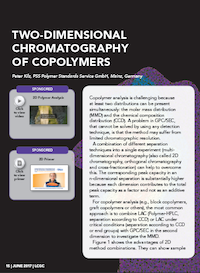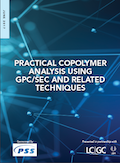Two-Dimensional Chromatography of Copolymers
Copolymer analysis is challenging because at least two distributions can be present simultaneously: the molar mass distribution (MMD) and the chemical composition distribution (CCD). A problem in GPC/SEC, that cannot be solved by using any detection technique, is that the method may suffer from limited chromatographic resolution.
A combination of different separation techniques into a single experiment (multidimensional chromatography (also called 2D chromatography, orthogonal chromatography and cross-fractionation) can help to overcome this. The corresponding peak capacity in an n-dimensional separation is substantially higher because each dimension contributes to the total peak capacity as a factor and not as an additive term.
For copolymer analysis (e.g., block copolymers, graft copolymers or others), the most common approach is to combine LAC (Polymer-HPLC, separation according to CCD) or LAC under critical conditions (separation according to CCD or end groups) with GPC/SEC in the second dimension to investigate the MMD.
Investigating 3D-Printable Stationary Phases in Liquid Chromatography
May 7th 20253D printing technology has potential in chromatography, but a major challenge is developing materials with both high porosity and robust mechanical properties. Recently, scientists compared the separation performances of eight different 3D printable stationary phases.
Detecting Hyper-Fast Chromatographic Peaks Using Ion Mobility Spectrometry
May 6th 2025Ion mobility spectrometers can detect trace compounds quickly, though they can face various issues with detecting certain peaks. University of Hannover scientists created a new system for resolving hyper-fast gas chromatography (GC) peaks.
University of Oklahoma and UC Davis Researchers Probe Lipidomic Profiles with RP-LC–HRMS/MS
May 6th 2025A joint study between the University of Oklahoma Health Sciences Center (Oklahoma City, Oklahoma) and the UC Davis West Coast Metabolomics Center (Davis, California) identified differentially regulated lipids in type 2 diabetes (T2D) and obesity through the application of reversed-phase liquid chromatography-accurate mass tandem mass spectrometry (RP-LC-accurate MS/MS).

.png&w=3840&q=75)

.png&w=3840&q=75)



.png&w=3840&q=75)



.png&w=3840&q=75)









